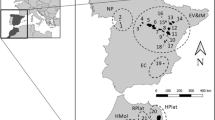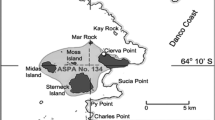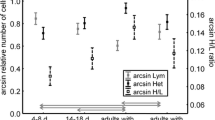Abstract
The Antarctic Peninsula is one of the areas where the climate is changing at the fastest pace, having several effects on the populations of pygoscelid penguins. Few studies have analysed the variation in immune parameters of antarctic birds in a geographical context; thus, analyses of geographical differences in the immune components of wild pygoscelid penguins are still scarce. Leukocyte counts in birds provide information on their immunity and physiological stress. The objective of this study was to analyse the leukocyte counts in penguins of the genus Pygoscelis (gentoo, Adélie and chinstrap penguins), covering sites along the South Shetland Islands and some islands on the west coast of the Antarctic Peninsula. Our results revealed differences in the number of heterophils and eosinophils and in the heterophil/lymphocyte ratio in the northeastern populations of gentoo and Adélie penguins as compared to the rest of the colonies studied. The results contribute to better understanding of the variations in physiological parameters of penguins related to a geographical context.


Similar content being viewed by others
References
Adamo S (2004) How should behavioural ecologists interpret measurements of immunity. Anim Behav 68:1443–1449
Ainley D, Tin T (2012) Antarctica. In: Hilty JA, Chester CC, Cross MS (eds) Climate and conservation. Island Press, Washington, pp 267–277
Ainley D, Russell J, Jenouvrier S, Woehler E, Lyver O’B, Fraser WR, Kooyman GL (2010) Antarctic penguin response to habitat change as Earth’s troposphere reaches 2 °C above preindustrial levels. Ecol Monogr 80:49–66
Apanius V (1998) Stress and immune defense. Adv Stud Behav 27:133–153
Atkinson A, Siegel V, Pakhomov E, Rothery P (2004) Longterm decline in krill stock and increase in salps within the Southern Ocean. Nature 432:100–103
Banbura J, Skwarska J, Banbura M, Gladalski M, Holysz M et al (2013) Spatial and temporal variation in heterophil-to-lymphocyte ratios of nestling passerine birds: comparison of blue tits and great tits. PLoS ONE. doi:10.1371/journal.pone.0074226
Barbosa A, Palacios MJ (2009) Health of Antarctic birds: a review of their parasites, pathogens and diseases. Polar Biol 32:1095–1115. doi:10.1007/s00300-009-0640-3
Barbosa A, Merino S, Benzal J, Martinez J, Garcia-Fraile S (2007a) Geographic variation in immunoglobulin levels in pygoscelid penguins. Polar Biol 30:219–225. doi:10.1007/s00300-006-0175-9
Barbosa A, Merino S, Benzal J, Martinez J, Garcia-Fraile S (2007b) Population variability in heat shock protein among three Antarctic penguin species. Polar Biol 32:1239–1244. doi:10.1007/s00300-007-0284-0
Barbosa A, Benzal J, Vidal V, D’Amico V, Coria N, Diaz J, Motas M, Palacios Motas MJ, Cuervo J, Ortiz J (2011) Seabird ticks (Ixodes uriae) distribution along the Antarctic Peninsula. Polar Biol 34:1621–1624. doi:10.1007/s00300-011-1000-7
Barbosa A, Benzal J, De León A, Moreno J (2012) Population decline of chinstrap penguins (Pygoscelis antarctica) on Deception Island, South Shetlands, Antarctica. Polar Biol 35:1453–1457. doi:10.1007/s00300-012-1196-1
Barbosa A, Eva De Mas E, Benzal J, Diaz JI, Motas M, Jerez S, Pertierra L, Benayas J, Justel A, Lauzurica P, Garcia-Peña FJ, Serrano T (2013) Pollution and physiological variability in gentoo penguins at two rookeries with different levels of human visitation. Antarct Sci. doi:10.1017/S0954102012000739
Butler MW, McGraw KJ (2010) Relationships between dietary carotenoids, body tissue carotenoids, parasite burden, and health state in wild mallard (Anas platyrhynchos) ducklings. Arch Biochem Biophys 504:154–160
Campbell TW (1995) Avian hematology and cytology. Iowa State University Press, Ames
Carlini R, Coria NR, Santos MM, Negrete J, Juares MA, Daneri GA (2009) Responses of Pygoscelis adeliae and P. papua populations to environmental changes at Isla 25 de Mayo (King George Island). Polar Biol 32:1427–1433. doi:10.1007/s00300-009-0637-y
D’Amico VL, Bertellotti M, Diaz JI, Coria N, Vidal V, Barbosa A (2014a) Leucocyte levels in some Antarctic and non-Antarctic penguins. Ardeola 61:145–152. doi:10.13157/arla.61.1.2014.145
D’Amico VL, Coria N, Palacios MG, Barbosa A, Bertellotti M (2014b) Physiological differences between two overlapped breeding Antarctic penguins in a global change perspective. Polar Biol. doi:10.1007/s00300-014-1604-9
Daszak P, Cunningham AA, Hyatt AD (2000) Emerging infectious diseases of wildlife: threats to biodiversity and human health. Science 287:443–449
Davis AK (2005) Effects of handling time and repeated sampling on avian white blood cell counts. J Field Ornithol 76:334–338
Davis AK, Maney DL, Maerz JC (2008) The use of leukocyte profiles to measure stress in vertebrates: a review for ecologists. Funct Ecol 22:760–777. doi:10.1111/j.1365-2435.2008.01467.x
De Mas E, Benzal J, Merino S, Valera F, Palacios MJ, Cuervo JJ, Barbosa A (2015) Erythrocytic abnormalities in three Antarctic penguin species along the Antarctic Peninsula: biomonitoring of genomic damage. Polar Biol. doi:10.1007/s00300-015-1667-2
Diaz JI, Fusaro B, Longarzo L, Coria NR, Vidal V, Jerez S, Ortiz J, Barbosa A (2013) Gastrointestinal helminths of Gentoo penguins (Pygoscelis papua) from Stranger point, 25 de Mayo/King George Island, Antarctica. Parasitol Res. doi:10.1007/s00436-013-3341-3
Ducklow HW, Baker K, Martinson DG, Quetin LB, Ross RM, Smith RC, Stammerjohn SE, Vernet M, Fraser WR (2007) Marine pelagic ecosystems: the West Antarctic Peninsula. Philos Trans R Soc Lond B 362:67–94
Fan T, Deser C, Schneider DP (2014) Recent Antarctic sea ice trends in the context of the Southern Ocean surface climate variation since 1950. Geophys Res Lett 41:2419–2426. doi:10.1002/2014GL059239
Flores H, Atkinson A, Kawagushi S, Krafft B, Milinevsky G, Nicol S, Reiss C, Tarling GA, Werner R, Bravo Rebolledo E, Cirelli V, Cuzin-Roudy J, Fielding S, Groeneveld J, Haraldsson M, Lombana A, Marschoff E, Meyer B, Pakhomov EA, Rombolá E, Schmidt K, Siegel V, Teschke M, Tonkes H, Toullec J, Trathan P, Tremblay N, Van de Putte A, van Franeker JA, Werner T (2012) Impact of climate change on Antarctic krill. Mar Ecol Prog Ser 458:1–19. doi:10.3354/meps09831
Grimaldi WW, Seddon PJ, Lyver PO’B, Shinichi Nakagawa S, Tompkins DM (2014) Infectious diseases of Antarctic penguins: current status and future threats. Polar Biol. doi:10.1007/s00300-014-1632-5
Harvell CD, Mitchell CE, Ward JR, Altizar S, Dobson AP, Ostfeld RS, Samuel MD (2002) Climate warming and disease risks for terrestrial and marine biota. Science 296:2158–2162
Jerez S, Motas M, Palacios MJ, Valera F, Cuervo JJ, Barbosa A (2011) Concentration of trace elements in feathers of three Antarctic penguins: geographical and interspecific differences. Environ Pollut 159:2412–2419. doi:10.1016/j.envpol.2011.06.036
Johnsen TS, Zuk M (1999) Parasites and tradeoffs in the immune responses of female red jungle fowl. Oikos 86:487–492
Lessells CM, Boag PT (1987) Unrepeatable repeatabilities: a common mistake. Auk 104:116–121
Lobato E, Moreno J, Merino S, Sanz JJ, Arriero E (2005) Haematological variables are good predictors of recruitment in nestling pied flycatchers (Ficedula hypoleuca). Ecoscience 12:27–34
Lynch HJ, Naveen R, Trathan PN, Fagan WF (2012) Spatially integrated assessment reveals widespread changes in penguin populations on the Antarctic Peninsula. Ecology 93:1367–1377. doi:10.1890/11-1588.1
Martinson DG, Stammerjohn SE, Iannuzi RA, Smith RC, Vernet M (2008) Western Antarctic Peninsula physical oceanography and spatio-temporal variability. Deep Sea Res II 55:1964–1987. doi:10.1016/j.dsr2.2008.04.038
Meredith MP, King JC (2005) Rapid ocean climate change at the WAP. Geophys Res Lett 32:L19604. doi:10.1029/2005GL024042
Montes-Hugo M, Doney SC, Ducklow HW, Fraser W, Martinson D, Stammerjohn SE, Schofield O (2009) Recent changes in phytoplankton communities associated with rapid regional climate change along the Western Antarctic Peninsula. Science 323:1470–1473
Morales J, Moreno J, Merino S, Tomás G, Martínez J, Garamszegi LZ (2004) Associations between immune parameters, parasitism, and stress in breeding pled flycatcher (Ficedula hypoleuca) females. Can J Zool 82:1484–1492. doi:10.1139/Z04-132
Müller C, Jenni-Eiermann S, Jenni L (2011) Heterophils/lymphocytes-ratio and circulating corticosterone do not indicate the same stress imposed on Eurasian kestrel nestlings. Funct Ecol 25:566–576. doi:10.1111/j.1365-2435.2010.01816.x
Rice WR (1989) Analyzing tables of statistical tests. Evolution 43:223–225
Roitt I, Brostoff J, Male D (2001) Immunology. Mosby, London
Shutler D, Marcogliese DJ (2011) Leukocyte profiles of Northern Leopard Frogs, Lithobates pipiens, exposed to pesticides and hematozoa in agricultural wetlands. Copeia 2:301–307
Sokal RR, Rohlf FJ (1995) Biometry. W.H. Freeman, New York
Sutherst RW (2001) The vulnerability of animal and human health to parasites under global change. Int J Parasitol 31:933–948
Trivelpiece WZ, Hinke JT, Miller AK, Reiss CS, Trivelpiece SG, Watters GM (2011) Variability in krill biomass links harvesting and climate warming to penguin population changes in Antarctica. Proc Natl Acad Sci USA 108:7625–7628. doi:10.1073/pnas.1016560108
Turner J, Bindschadler RA, Convey P, Di Prisco G, Fahrbach E, Gutt J, Hodgson DA, Mayewski PA, Summerhayes CP (2009) Antarctic climate change and the environment. SCAR, Cambridge, ISBN: 978 0 948277 22 1
Vanstreels RET, Miranda FR, Ruoppolo V, de Almeida Reis AO, Schneider Costa E, de Lira Rodrigues, Pessôa A, Machado Torres JP, Teixeira Schmauder, da Cunha L, da Cruz Piuco R, Valiati VH, González-Acuña D, Labruna MB, Petry MV, Epiphanio S, Catão-Dias JL (2014) Investigation of blood parasites of pygoscelid penguins at the King George and Elephant Islands, South Shetlands Archipelago, Antarctica. Polar Biol 37:135–139. doi:10.1007/s00300-013-1401-x
Vaughan DG, Marshall GJ, Connolley WM et al (2003) Recent rapid regional climate warming on the Antarctic peninsula. Clim Change 60:243–274
Vleck CM, Vertalino N, Vleck D, Bucher T (2000) Stress, corticosterone, and heterophil to lymphocyte ratios in free-living Adélie penguins. Condor 102:392–400
Zinsmeister VAP, VanDerHeyden MJN (1987) Differential leucocyte counts from Pygoscelid penguins of Antarctica. J Wildl Dis 23:521–552
Zuk M, Stoehr AM (2002) Immune defense and host life history. Am Nat 160:9–22. doi:10.1086/342131
Acknowledgments
We appreciate the hospitality and logistic support of the Argentinean Antarctic Base “Carlini” and the Spanish Antarctic Base “Gabriel de Castilla”. We also thank the Spanish Polar Ship “Las Palmas”, which provided us with the logistic support and transport to the localities. We thank the logistic support provided by the Marine Technology Unit (CSIC) and Instituto Antártico Argentino (IAA). Permission to work in the study area and for penguin handling was given by the Spanish Polar Committee. We are very grateful to B. Fusaro and L. Longarzo for their help at “Carlini”. We thank Dr. Ralph Eric Thijl Vanstreels and the two anonymous reviewers for their insights, which have significantly improved our manuscript. Ma. Victoria Gonzalez Eusevi from Ingles Científico (www.inglescientifico.com) corrected the English language of the manuscript. This study was funded by the Spanish Ministry of Science and Innovation (Grant CGL2007-60369 and CTM2011-24427). VLD had a CONICET Postdoctoral fellowship and VV was supported by a Ph.D. Grant from the Spanish Council of Scientific Research (CSIC) and the European Social Fund (JAEPre08-01053). This study is a contribution to the International Polar Year project Birdhealth and to PINGUCLIM project.
Author information
Authors and Affiliations
Corresponding author
Rights and permissions
About this article
Cite this article
D’Amico, V.L., Marcelo, B., Benzal, J. et al. Leukocyte counts in different populations of Antarctic Pygoscelid penguins along the Antarctic Peninsula. Polar Biol 39, 199–206 (2016). https://doi.org/10.1007/s00300-015-1771-3
Received:
Revised:
Accepted:
Published:
Issue Date:
DOI: https://doi.org/10.1007/s00300-015-1771-3




